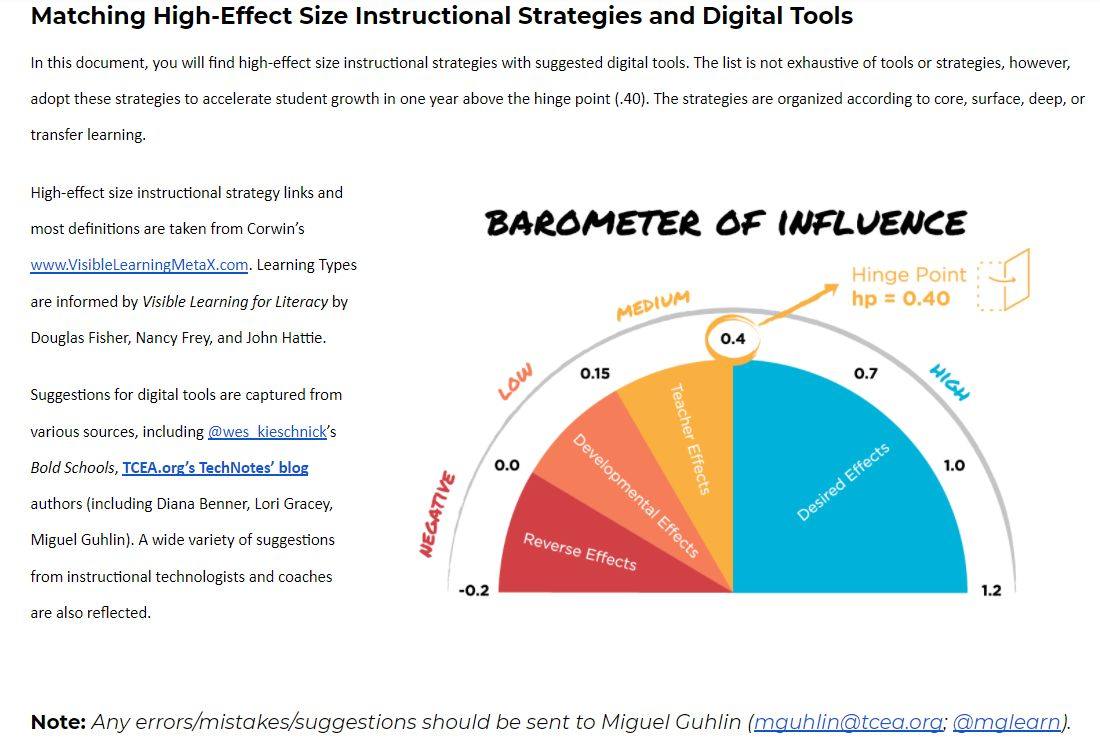Wonder what technologies you can blend into high-effect-size instructional strategies? In this blog entry, I revisit the revised Strategies That Work app that you can use on your mobile device. It also works in your desktop’s or laptop’s web browser. Read the “Coaching for Results” series, yet? If so, you know how to match instructional strategies with technology. You can make those strategies relevant to how children learn today with technology.

Get app online at https://tceastrategies.glideapp.io
Strategies That Work
In the Strategies That Work app, I shared several important instructional strategies. The app makes it easy to find information about each one. A recent update now includes a list of suggested technologies for each strategy. Find it online at https://tceastrategies.glideapp.io
If you’d rather not work with an app on your device, there’s another option.
Access Strategies via a Google Doc
In this Google Doc, you will find a list of strategies that you might want to use in your classroom. Matched to each is the latest description and effect size from the Visible Learning Meta X database. You will also find a column with a list of technologies that teachers and students may use. The purpose of the technology list is to complement and expand what you may know about using them.

Access chart online at http://ly.tcea.org/mst
Let’s take a quick look at two examples. We’ll explore how a single technology and single instructional strategy work together. The strategies and matching technology are in four categories, including the ones I referenced in my “Coaching for Results” series.
Example #1: Summarization (d=0.74)
Although it lacks the punch of a strategy that accelerates three or more years of student growth, summarization is a critical one to know and use. The Visible Learning MetaX database defines summarization in this way:
The ability to summarize a text is often taken as a marker of reading comprehension. Many scholars have advocated explicit summarization training for students who struggle with comprehension. This can include deleting unnecessary material or materials that is redundant. It can involve substituting a subordinate term for a list of items or actions. Or, the summarizer may select a topic sentence or constructing a topic sentence if one is implicit in the text.
When asking students to summarize, we can have them engage in any one of the following activities:
- Traditional paper-and-pencil activities
- Verbal activities as part of reciprocal teaching strategies
- Recording some form of multimedia
Several technologies lend themselves to the use of summarization. While there are some obvious connection, one key component of summarization involves annotation. Digital annotation of websites and digital documents can prove quite useful.
Some typical tools for annotation appear below:
Each tool has much to offer within its sphere of influence for annotation purposes. Digital documents (e.g. PDFs, Google Docs, Microsoft Word) offer many opportunities for student-led annotations. Even tools like Amazon’s Kindle eReader app have made annotation easy, and exporting those into other documents straightforward.

“Hypothesis is my literary Facebook. When I’m reading I sometimes wonder, does anyone actually understand this? Am I crazy? With this brilliant tool I know I’m not alone,” says Shannon Griffiths, Student, Plymouth State University.
Give Hypothes.is a try with a team of professional learners. You can add it to your Chrome browser since it has an extension.
Example #2: Mnemonics (d=0.80)
While not my first go-to strategy to use, I can see why mnemonics is an under-estimated teaching technique. Mnemonic instruction works for students with learning problems, including learning disabilities (LD) or mild intellectual disability (MID) (source). The Visible Learning Meta X database defines mnemonics in this way:
A practice by which students learn a significant amount of information for long-term recall by memory. There are five classes of mnemonics: linguistic, spatial, visual, physical, and verbal.
These five classes may be expanded in the following way, as adapted from Lubin and Polloway (2016):
- Linguistic: Pegword and keyword methods form this approach. They associate a new idea with familiar words and/or phrases to help remember the item.
- Spatial: This uses the loci, spatial grouping, and finger methods. Each connects a new concept to a familiar place, pattern, or finger. This aids in memorization of the material.
- Visual: These rely on pictures or visualizations that create an association to the target concept (e.g., symbolics, pictographics).
- Physical: This approach makes use of the body parts to aid in remembrance. Do this via movement or physical sensation.
- Verbal: This method uses meaning and stories to help students remember. Some approaches may rely on grouping, semantic organization, and story-telling or narrative chains.
How do you go about storing information for long-term memory recall? You use a mnemonic. While it’s easy to create a linguistic mnemonic focused on keywords, others may be as much fun.

Image Source: Visual Mnemonic Examples
To make linguistic mnemonic (e.g. keywords) creation easier, consider the use of tools (some may be inappropriate for younger students) such as:
To make pegword mnemonics, you need an app or paint software. This comes standard on many computers, not to mention is available as part of Google and Microsoft Office Suites. One can imagine students creating pegword mnemonics using an iOS app like Doodle Buddy.

Image Source: IRIS | Pegword Method
Connecting Conclusions
As you can see, the more you know about an instructional strategy, the easier it is to use technology as a part of it. Applying them in the classroom will involve drawing a connection. The connection must be made between learning outcomes and how the tech will be used.

